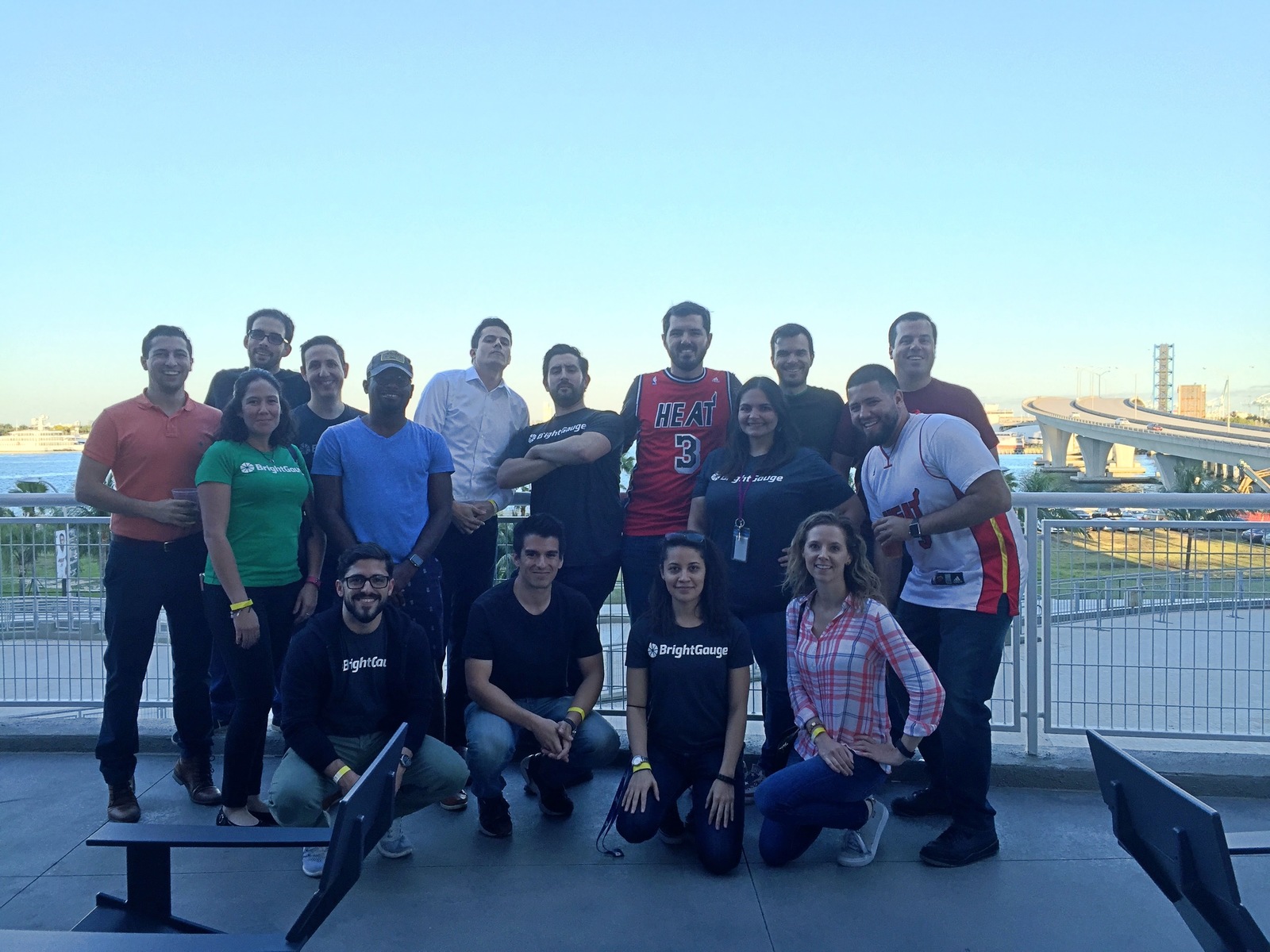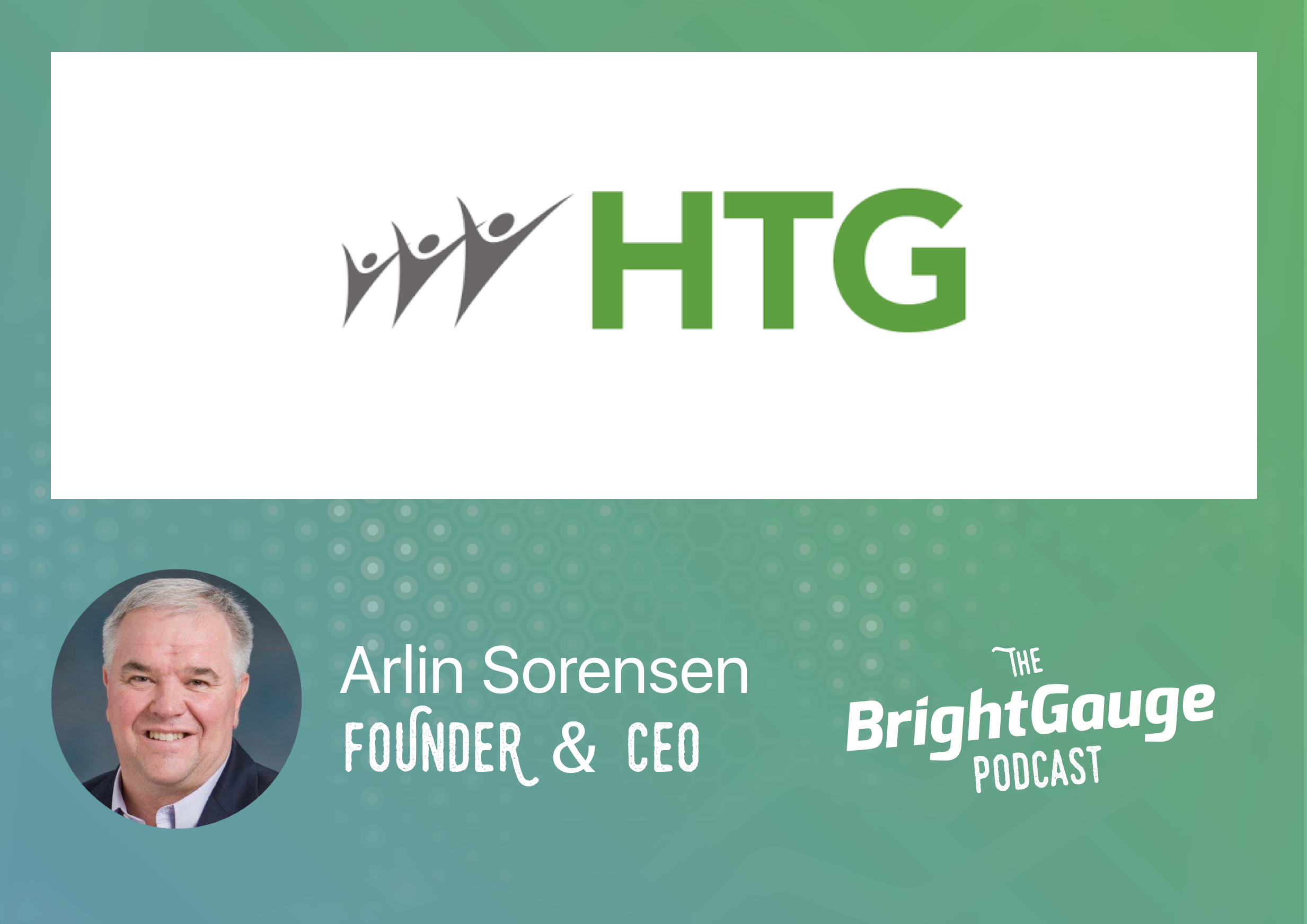As peer groups become more popular in the IT Services channel, we often get questions about what to expect and what will be accomplished by joining one. We were recently joined by Arlin Sorensen, ...
As peer groups become more popular in the IT Services channel, we often get questions about what to expect and what will be accomplished by joining one. We were recently joined by Arlin Sorensen, Founder and CEO of HTG Peer Groups, to learn more about the mission and vision behind the organization. After dispelling the idea that peer groups are only focused on how to drive more profit, Arlin explains the belief that is the cornerstone of HTG, “success in one area of life doesn’t really lead to true success and happiness.” He goes on to explain how a combination of leadership, legacy, life plan, and business plan help to achieve true success, lessons on how to drive up business valuations, and the importance of investing in your people. Business, Leadership, Life & Legacy: Episode Highlights Arlin’s intro and background (0:42) Current trends in the MSP industry: cloud, IOT, security and more (4:13) A closer look at the typical type of customers who work with HTG Peer Groups (7:38) The most common challenge for MSPs is sales (11:29) The 4 plans: HTG’s core beliefs of the components of true success (14:39) Things people should consider to help drive up business valuations (22:11) Helping leadership teams map out a strategy for the future with StratOp and personal planning with LifePlan (26:17) Where is HTG headed in the next 12-18 months? (33:34) Advice for MSPs about investing in your people and building a sales organization (35:50) Q&A: best business book, favorite personal development resource, parting advice, and how to reach Arlin (39:13) Best book as mentioned in the episode: Great by Choice: Uncertainty, Chaos, and Luck - Why Some Thrive Despite Them All, by Jim Collins Want to find out more about The BrightGauge Podcast? Check out all the episodes here.

As your MSP business grows, your teams throughout the company must adapt. In the beginning, every employee will need to wear several hats and possess a generalist skill set to meet demands with a small team. Then as your business expands, you’ll be able to bring more talent on board and create smaller, specialized roles for your employees. The real trick to smooth sustained growth is recognizing the right time to shift strategies. While generalists are a key component of early success, they become less helpful as the company grows. Let’s take a look at some helpful tips for structuring your MSP team through the different stages of growth: Generalists Are a Powerful Resource As an MSP, it makes sense to hire the cream of the crop. What IT provider wouldn’t benefit from having experts in every service that they offer? Unfortunately, hiring those experts may not be a realistic option for young companies who are just trying to get their foot in the door. In the early going, generalists are a vital resource that will keep your business afloat and put you in a position to grow. That is why with your first hires, you should seek out employees that have a wide breadth of knowledge that can help fulfill multiple roles. This helps young MSPs to keep their costs down without neglecting the vital services that clients need. Finding a reliable teammate who can go from troubleshooting network issues to answering support tickets, to hopping on a sales call provides flexibility that is a huge help to small teams. Creating Lanes of Focus One downside of hiring generalists is that they may not possess the specialized skills needed to make the shift to specialization later on. If your MSP is entering a scaling phase, you should point employees in the direction of a more specialized focus without sacrificing their flexibility. We recommend creating “lanes of focus” which spotlight unique skill sets for each individual employee. This allows them to handle requests that fall into their area of expertise and provides a roadmap for career development, yet they can also help out team members with other tasks. When you first start your MSP, your engineers will have their hands in many aspects of the business. Their duties may include remote work, field work, help desk work, or project work. As time goes on, you’ll hire both Level I and Level II engineers and split up those duties. Level I engineers may do most of their work remotely, but every now and then may be required in the field. On the flip side, your Level II engineers may spend most of their time in the field, but also may be required to answer calls from the help desk on occasion. This is beneficial to both the company and employees as they gain experience in a variety of tasks but have a defined focus for future training and development. As your team continues to grow, you should look to limit hiring generalists and instead focus on specialists. Start exploring specialization options for generalists early on in their employment. Over time, you can continue training in those areas and help convert them into a more specialized role. Team Size and Management Needs As your teams grow, ensure that you never allow a team to get too big without promoting or hiring a manager. Teams that grow too large without a leader are likely to become disorganized and ineffective. Any team with 6 to 8 team members must have a manager to help guide the team and stay focused. In the beginning, that manager may have to play the part of both a player and a coach, managing the team and also getting their hands dirty with the day-to-day work. As the team stabilizes, they can transition into a pure management role. When your MSP reaches the stage of hiring managers, it can be an exciting and nerve-racking time. It's an expensive undertaking, but one that is necessary to facilitate growth. Hiring managers also means a longer, more in-depth hiring process as each manager will play a critical role in the success of your company. Conclusion At BrightGauge, we know the growth challenges you face because we also had the same experience while growing our MSP. Navigating the issues that come with that growth can be difficult, especially as policies and strategies change. Missteps in employee management, hiring, and delegation can stifle what would be a healthy growth rate. Rather than find yourself unprepared later in the game, remember the benefits of hiring generalists in your early stages, and then strategically shift toward specialization, and you're sure to succeed in all stages of your business. Want to continue the conversation on hiring for your organization? Listen in on our podcast featuring John Davenjay, CEO of the IT Services staffing firm Bowman Williams, for a conversation on finding and keeping the right employees in an MSP.

At a recent workshop we hosted at our office for customers, I spent quite a bit of time explaining how we build our product at BrightGauge and how we prioritize what we build. We had 15 attendees and they each had a few features they wanted us to add in the product and, very fairly, they were just trying to pinpoint when those features would be available. The short answer I had to tell them (in a somewhat joking way) was “we have no idea”. Because the reality is that we do not maintain a well defined, detailed roadmap of any significant timeline. There were a lot of blank faces when I said that, but it was the truth. Most of the features they asked for we definitely want to build... so I couldn’t even say “no we’re not going to do that”. The reality is we have over 150 features, small and large, on our backlog and we want to get to them all. Therefore the only thing we can really focus on is prioritization and iteration. We continued to have the conversation and here’s the high level of what I explained to sync up up on how we do it at BrightGauge: Things Change Over Time, Small Iterations are Key Like any technology business, the only constant is change. We know this and it’s why the popular agile development process has become so pervasive. Our agile process has us doing work in “2 week sprints” where we commit to a bunch of work to do in just 2 weeks. Ultimately, that’s why I gave that joking answer about not knowing when things are coming out because we only know what’s on the coming 2 week sprint. We keep iterating every two weeks and re-prioritizing and reworking the requirements, etc. It’s all about iterating. We Work in Themes Essentially, from a broader perspective we do know what we want to get done from a high level and we call those “themes”. These themes span over quarters typically (and some cases an entire year) but most of the time themes don’t translate into exact features customers would expect. They are instead of phrases or a word that describes the goals: Here are some previous examples: Put Billing in the app (Q4 2016) Launch Scorecards v1 (Q4 2016) Launch Leaderboard Gauges (Q2 2016) These themes are broad strokes that contain a whole bunch of little features inside of them. We used to talk about these themes publicly in 2015 but what happens is themes can mean different things to different people. “Improve Report Builder” may mean page breaks to one person or custom fonts to another. To us, the themes are just where the focus is going to be for the set period of time. We know the first few features that we’ll develop as part of the themes but after that we let priorities shift based on where we’re at in a sprint and in a quarter. Priorities always shift slightly within a theme based on long term vision, customer feedback, internal debate, resource constraints, etc. So the themes are loose in definition but keep us focused over a set period of time. Constant Delightful Features As much as we love themes, we don’t want to be bound to just a few areas of the application to improve at one time. We always want to be releasing small improvements (we call them delightful features) that span across our entire product. These delightful features are small, bite sizable things we want to do that we don't want to wait until a larger theme is greenlighted. If/when the themes aren’t soaking up all resources, we throw delightful features in the mix based on the same inspiration as themes (vision, customer feedback, internal debates, resources, etc). When I explained this one to the workshop, we decided to have some fun and prioritize their wish list as an exercise. We asked everyone to submit their feature request list to us during the session. We then removed the far fetched wild ones or the ones that need to be part of larger themes. What was left was a bunch of “delightful features” folks wanted (80% of them). So we had the group pick their top 3. And the ones with most votes we then committed to doing over the following three months since they were on our backlog anyway. Since then (6 weeks ago) we’ve done three of them (Text Module in Dashboards, Scheduled Reports per client, and Goal line in bar charts). Summary It can be frustrating to not have a roadmap to hand out to customers or prospects. Trust me, I’d love to have a detailed plan. But the reality is it would just be rubbish since the above holds true. But I can tell you that right now, as of May 2017, our current themes are: Overhaul Report Builder Improve Out Of the Box defaults for new and existing customers Improve onboarding workflow for new customers We do look at the feature request board all the time, even if we do not necessarily comment on them (there’s 500 posts on there). We look at the items that get the most votes as well to keep us honest on what we pull on each sprint. Please keep providing feedback as it definitely does impact our internal plans! And if you ever have any specific questions, feel free to contact our support team and they can provide insights. We’re fairly transparent here so they can share what they know when you connect.

We’re excited to announce our new integration with IT Glue, the documentation solution built specifically for MSPs! IT Glue, the SOC 2 compliant IT documentation platform, keeps critical application, device, and password information at your fingertips. And because IT Glue eliminates the need for spreadsheets or wikis, your team will be more organized and efficient than ever before. How to Make Data Driven Decisions with IT Glue + BrightGauge With IT Glue data in your BrightGauge, it’s easy to monitor each team member’s progress towards achieving their documentation goals. You’ll never again have to wonder if your team is using the tools you provide them! IT Glue Configurations Monitoring: With a configurations dashboard, you’ll see configurations by type or by warranty status at a glance, while also monitoring your organization’s efforts towards documentation updates. IT Glue Internal Report Templates: It’s effortless to create a unique, automated report to keep your team updated on documentation activity using an IT Glue User and Document Metrics Weekly report. Just set up the report once and your team will stay up to date with the most important data points delivered right to their inbox, without the need for additional meetings! Custom Leaderboard Gauge: Your team has dozens of documentation updates to keep up with each day, but it’s easy for those updates to fall through the cracks as other tasks compete for their attention. That’s where a User Points This Month Leaderboard helps to pick up the pace, because it’s easy to see each Tech’s efforts towards creating, editing, viewing, or deleting documentation. With a point system and badges to effortlessly track progress, it’s easy for you to coach or congratulate each team member based on their performance, while productivity improves across the board with a little friendly competition to see who can rule the top of the board! To learn more about managing your documentation data alongside all the other metrics that run your business, visit IT Glue + BrightGauge. Please note that this integration requires API access, which is included in IT Glue’s Enterprise plan.

We’re excited to welcome Daniel Silva to our team as Customer Support Specialist! Join us in learning more about the latest member of the growing BrightGauge crew... The Early Days Born and raised in the Miami area, Danny knew early on that tech pursuits were on his radar. In high school, he joined the Academy of Engineering and the Academy of Technology, where students were always encouraged to use the hardware lab and compete in as many competitions as they wanted to including Danny’s personal favorite: robotics. In addition to the engineering focus, Danny also spent time on programming and taking courses through the Cisco Networking Academy. His experience ultimately led him to Miami-Dade College, where he’s still working towards a degree in Computer Science. Diving Into Support and Managed Services Danny’s first intro to Support was an internship with Miami Dade County Public Schools, where he spent his time focused on upgrading / fixing computers, setting up new labs, and handling support tickets from the staff. Then he ventured into a programming internship with local MSP, ICG, although his focus was soon moved to the Internal Projects team. There he spent time working on updates for client documentation, setting up e-signatures, and eventually moved onto Purchasing. Most importantly, as luck would have it, one of the projects that fell on Danny’s plate during his ICG days was implementing BrightGauge for the MSP. And as the saying goes, the rest is history! Joining BrightGauge As Danny tells it, his time spent in Purchasing and Internal Projects at the MSP was really a behind the scenes role. He decided it was time to try something new and when he came across the Support opening at BrightGauge, he was excited about the opportunity to be part of a team, focus on a more customer-facing role, and work for a company that is very family-oriented. Not to mention, after working on the implementation, he already felt comfortable using our product and working with the other members of our incredible support team! Danny goes on to explain, “I’m excited to be surrounded by an awesome team and also learning a lot from the development team... and I can’t wait to see more of the behind the scenes of how this product works.” After Hours Outside the office, Danny is a big fan of games, movies, and comics. He loves getting away to Orlando for just about any excuse he can think of, where he enjoys quick visits to Disney World, as well as nearby Cape Canaveral for rocket launches and landings. After attending a few local comic cons and many years of watching videos with people showing how to recreate TV and movie props, Danny’s most recent hobby is crafting. He’s working his way towards understanding how to create his own wearable or decor-focused masterpieces. Join us in welcoming Danny to Team BrightGauge!

70+ Metrics for MSPs
Key metrics and accompanying formulas to help MSPs skyrocket growth and success!
Get your KPIs

For MSPs, there are few metrics more critical to your business success than customer satisfaction (CSAT) scores. We live in a world that demands instant gratification, and clients have high demands for their IT providers. Measuring the satisfaction of your customers provides insight into your operational efficiency, sheds light on your customer’s concerns, and highlights strengths. But, simply collecting CSAT data isn’t enough if you aren’t using it to improve your services. According to a report from Esteban Kolsky, one of the most widely recognized names behind the science of customer experience, 70% of companies that deliver best in class customer service use customer feedback to their advantage. Put another way, improving your organization’s service requires that you work with your clients to evolve your processes and increase communication. We recommend sharing customer satisfaction results directly with the customers themselves. Initially, this might seem to be a bit of a risky choice. Letting your customers see where your service could improve could open their eyes to issues they were unaware of. The other side of the coin is that exposing your customers to what you are doing right can help them to better appreciate your service. There are a few reasons why MSPs should consider sharing their CSAT scores with customers: Open Opportunities for Additional Feedback After collecting customer satisfaction feedback and analyzing the results, the thought of sending that data to your customers might make your heart flutter. But, doing so gives you the opportunity to explore issues with management and work together to find a solution. According to a report from Ruby Newell-Legner, the fan experience expert who advises dozens of professional sports teams and other organizations, the average business only hears from 4% of its dissatisfied customers. While this retail example doesn’t specifically relate to MSPs, it does show that sometimes it can be difficult to convince clients to speak up about issues. No one likes to deliver bad news, especially if they are generally satisfied with their overall service. Allowing your them to see the data might prompt them to be a bit more forthcoming, or dig deeper into specific issues their team has encountered. If you’re reading this and thinking that you always feel the heat from unhappy customers, ask yourself: are there quiet ones who you assume are happy, because you haven’t brought up the conversation? Why risk making that assumption, only to have their business slip away at the end of your contract? The same is true for positive responses as well. When you share CSAT scores with your customers, you open their eyes up to what is going well. Remember that no one is infallible. Management may make assumptions about your service and how their team feels about it. By providing in-depth CSAT research you ensure that their understanding of your service level is accurate. Identify Inconsistencies in Customer Satisfaction MSPs should share CSAT data with a client’s management team so they have an idea of how their staff was treated across the board, as Karl Fulljames, VP of Operations at Nucleus Networks recently explained in a BrightGauge customer poll. Often, the opinions and satisfaction levels in upper management can differ from those in lower level positions. The lower levels are the ones that interface with your team and are more likely to understand the issues that they commonly experience. Even the best-trained MSP teams may unwittingly give better service to clients in upper management. Ultimately the goal of any MSP is to ensure that their client’s IT operations run smoothly and make them a more profitable company. Those goals are often achieved through interactions with lower level support reps. Sharing internal customer satisfaction data will help MSPs work together with clients to create a smoother process for all involved. Display Transparency Clients love transparency from vendors. This is particularly true for MSPs that play a critical role in their operations. Sharing customer satisfaction data with your clients shows that you acknowledge where your service could improve while also highlighting where the relationship has been beneficial. By sharing feedback, you make the client an active presence in the improvement process, which is something they are sure to appreciate. Nick Olerud, Director of Technology at Netrix IT, explains that “transparency makes conversations with clients much easier if there is a bad week or day because they can see the overall trend of good service. It’s easier for clients to understand that mistakes happen and no one is perfect.” Identify & Create Brand Advocates Pinpointing potential brand advocates is important for bringing in referrals. Sharing your CSAT data with clients can be a great way to bring them into the fold. Upper management may not have a firm understanding of your daily interactions with their teams. But because they are the ones in a position to recommend your services, it is important to inform them and build relationships. Sharing your CSAT data can help nurture these relationships and keep your company at the top of their mind. Sharing CSAT data also opens the door to further collaboration. Highlighting issues you've faced and working to correct those issues shows clients that you are responsible and can help to shape their perception of your company. These interactions are a great way to raise their awareness of your company and services. The more aware upper management is of your company, the more likely they are to become a brand advocate and refer other businesses to you. Conclusion Every MSP knows how critical customer satisfaction is to a service-based business. However, too often companies are tight-lipped with results and unwilling to share them with their clients. Instead, try sharing your data with clients and use it as a relationship-building exercise.

Finding and hiring the right people can be be tricky for any company, but this is especially true for MSPs because you need your team to have in-depth technical knowledge. To make it even more challenging, your hires must also be the right fit for your company’s culture. At BrightGauge headquarters, we recently hosted our first Data Driven Workshop where we hosted 15 customers for three days of in-depth learning, peer networking, and best practices sharing. During the workshop, I was able to listen in on the sessions and one of the recurring themes that I noted was on the people side of the MSP business. Every single attendee, no matter the size of their MSP, wanted to trade ideas and try to improve their processes based on the shared experiences of the group. It’s hard to find good people! Period. We sometimes go through the same thing here at BrightGauge, and in reality SMBs across any industry struggle to find qualified applicants for open positions. In fact, a 2015 NFIB report explains that 47% of small businesses find themselves in the same position when it comes to filling open positions. And once you do assemble an awesome team, how do you make sure that you can keep them happy and engaged so that they stay with you instead of pursuing other options? Listening in on these conversations resulted in quite a few takeaways. While finding the right blend of technical skills and personality is difficult, you can master the process with a bit of commitment. Here are 6 ideas you can implement to ensure that your team is filled with motivated talent who are ready to grow your business, as shared by your MSP peers: Offer Internships Internships can be a great way to evaluate new talent and improve relationships with local universities. An internship of 90 or 180 days is typically required in most Bachelor's programs. While most internships are unpaid, it is important that any company that offers them doesn't just view them as cheap labor. Focusing on mentoring and training an intern pays dividends for both parties. Often, internships turn into long-term positions when the intern is a great fit. Interns can also provide a helping hand on projects and tasks that you are struggle to finish. Meanwhile, they're getting their feet wet with real industry experience. Keep a Bench of Potential Hires When filling a position, MSPs who are doing their due diligence should consider plenty of applicants. At times, you’ll likely meet with more than one candidate that you think would be a good fit for the position. Of course, it is only possible to fill the position with one person, but that doesn’t mean that the other applications should be thrown in the trash and the candidates forgotten. According to Harvard Business Review, 33% of new hires look for a new job within their first 6 months. Instead, hold onto those applications to fill future positions or to contact them if your new hire doesn’t work out. Start the Search Early and Take Your Time Sometimes companies will have advance notice of position vacancies or may not need to fill a position immediately. If the need isn't urgent, take the time and conduct interviews over the course of weeks or months. This provides a number of benefits: Evaluate more applicants. With a longer hiring period, you’ll be able to evaluate more applicants. Additionally, the longer time-frame allows you to be more picky about the candidates that you bring in for interviews. Add steps to the evaluation process. With more time, you give yourself the opportunity to meet with a candidate several times while evaluating them. Adding an extra phone interview, in-person interview, or even a working interview can be a great way to get to know each candidate better. Be more picky. When you rush into making a hiring decision, it’s hard to be picky. Are they qualified? Do they have the technical skills? In positions that must be filled quickly, answering those questions may be enough, but slowing down the hiring process allows you to evaluate how they fit within your company culture as well. Work with Local Schools One often overlooked avenue for attracting talented candidates during the hiring process is working directly with local schools to help shape their efforts in preparing students for hire. Reach out to local universities, community colleges, and technical colleges and ask about opportunities to be an Advisor for their curriculum and/or Career Services efforts. Schools are happy to have employer insights and gain a better understanding about what skills local companies are looking for because it helps them to boost their post-graduation employment numbers and attract more students. Additionally, working directly with professors helps to ensure that the candidates being sent your way are the top of their class. Offer Career Development One of the best ways to attract top level talent to any MSP is to offer career development, and it’s an especially solid strategy for smaller MSPs that may not have a lot to offer in the way of internal advancement. Remember that any new hire likely has greater aspirations than the position that you hire them for, whether inside your company or elsewhere. When applicants sense that a position could be a stepping stone to bigger and better things, they are more likely to apply. Although career development for employees can be an expensive investment, committing to a few hours per week can make a position much more attractive. Also note that the career development offered will usually be specific to the position, but sometimes you’ll have employees who are “green” and they’re not sure what they want to do. Help them figure it out, and by getting them on the path to something they are passionate about, you will usually earn their long-term loyalty. Training, certification, or even additional schooling are all excellent options for career development. Challenge and Reward Employees for Excelling Everyone knows that offering promotions and raises are the typical ways to keep employees motivated. But what about small MSPs that don’t have much wiggle room on salary, or are unable to offer promotions? What about employees that aren’t necessarily motivated by money? You’ll have to get creative to find ways to keep employees motivated. In the past, we’ve written about using games, contests, and rewards to improve employee engagement. Here are a few great ways to keep your teams motivated and reward them for exceptional work: Start contests and keep score publicly. All employees want to be rewarded when they do great work relative to their peers. BrightGauge's platform offers custom leaderboards to create and track employee competitions. Give trophies/mementos to employees that embody core company values. Every company talks about the traits that they would like their teams to exhibit. But how many companies actually show gratification when they do? Showing your appreciation for an employee that embodies a core company value can go a long way towards improving motivation, plus your employees will be proud of their accomplishment and want to show off the trophy on their workspace. At BrightGauge, we regularly give out the highly-coveted Top Banana award! Start a customer fantasy league. For MSPs there is no bigger win than helping a client become more profitable. Behind each profitability boost is the tools and employees that made it possible. Give out points to your team members and reward the highest scores for their excellent work! Learn More About Hiring and Retaining Top Talent Hiring and onboarding new employees, and then keeping them motivated long-term has unique challenges in the MSP industry. Learn more expert advice from John Davenjay, CEO of the IT Services staffing firm, Bowman Williams, on The BrightGauge Podcast, Finding and Keeping the Right Employees in an MSP.

In the world of MSPs, best practices and the importance of service team processes are often in the spotlight, but let’s not forget that a sales team also plays a critical role in shaping the company’s growth. At BrightGauge, we urge our MSP customers to first set the right standard for their sales team. That means encouraging your sales team to commit to strategies that promote long-term growth over short-term sales, by shifting their sales mindset toward lead nurturing. While it may sound like a huge undertaking, the secret is to have a sales processes that promotes these strategies. Let’s take a look at 5 of the sales best practices that we promote here at BrightGauge: Create colleagues One of the biggest mistakes that MSP sales teams make is focusing too much on closing the sale. That’s right. Sales are great, but building a mutually beneficial business relationship with prospects will yield better results in the end. According to a study by Marketing Donut, 20% of all clients will take 12 months or more to close the deal. Companies focused on short-term sales miss those opportunities. To foster long-term relationships, there are a few things that MSP owners should instruct their sales reps to focus on. First, focus on providing value. Whether they buy your services or not, a constant stream of value from your business helps to shape their impression. Face-to-face interaction is also important. In a world where B2B businesses connect online from across the globe, you’ll have to make face-time a priority. Emails are effective, but can only go so far. In long-distance business relationships, a video chat through Skype can go a long ways toward building a connection. Encourage your sales reps to engage in “servant sales” strategies. These strategies place priority on building trust and adding value, rather than focusing on making the sale. According to a Forrester Research report, companies that nurture leads make more 50% sales, while spending 33% less than companies that do not. Encourage your sales team to pursue relationships that may not pay off immediately, but show future promise. Establish a timeline Developing a positive relationship with a client requires that you not apply too much pressure. Pressuring the prospect to commit too quickly can ruin relationships and sour their opinion of your brand. Avoid this by encouraging sales reps to allow the prospect to dictate the timeline for the sale. This helps them feel at ease by putting them in the driver’s seat. Once you have a timeline for the ideal sale established, continue delivering value. Instruct your sales reps to regularly send relevant content. A DemandGen Report study found that 95.2% of B2B buyers preferred providers that used content to help them navigate the buying process. Stick to a process Just because an MSP commits to a longer sales approach, doesn’t mean that it needs to be without a process. Having a defined process creates repetition, allowing your sales reps to improve their pitch with each new prospect. For long-term sales engagements, a 5-7 step system can be immensely helpful to your sales teams. Of course, every engagement with a prospect is different. There must be wiggle room, but having that outline handy helps keep your team focused. Here’s an example of a system similar to the one we use here at BrightGauge, but customized for use by MSPs: Send Email(s). An email is an excellent, low-pressure way to gauge interest and introduce yourself. A few back-and-forth emails can be a great way to start building a relationship. Gauge Interest. Use a series of emails to learn about their company and gauge their need and interest. Follow-Up Phone Call. Once you’ve confirmed their interest, schedule a follow-up phone call. According to The Marketing Donut, only 2% of sales close during the first meeting, and the average sales process requires 5 follow-up calls to close the deal. Free Network Assessment Offer. A free offer is a great way to add value, build trust, and establish that your company is a good fit. Whether or not they become a client, you’ve provided them with valuable insights. Follow-Up Video Call or In-Person Meeting. Cement your relationship with the prospect. A face-to-face discussion is a great way to build a deeper connection, even if they aren’t interested in committing right away. Convey value A sales rep’s main goal should be to provide and convey value in all stages of the sales process. Taking the time to find relevant, valuable content helps to build a connection over time. Make that value clear to the prospect. When you send them content or speak about strategies on the phone, don’t be afraid to spell out exactly how it will help them. Connect the value you deliver to real business cases that the prospect understands. Aim to problem-solve The most important component of any engagement with a new prospect is ensuring that your services can solve their problem. An Impact Communications study found that 70% of B2B buyers make purchases to solve specific problems. A client that signs up for a service that they don’t truly need won’t be a client for long. In some ways, the relationship isn’t different than the one between a doctor and patient. A doctor wouldn’t prescribe headache medicine for a runny nose. If they did, they wouldn’t be that patient’s doctor for long. MSPs need to identify the best fit for their service to deliver exceptional value to clients. Evaluating their needs and ensuring that your services solve their problems will take time. Often, it isn't possible without accepting a longer sales process. Allowing your sales reps to take a long-term approach is empowering for both parties and will result in more meaningful business relationships. Learn more about long-term sales processes Interested in learning more about long-term sales processes that lead to high-value clients? Check out our Director of Sales, Larry Garcia, on Episode 2 of The BrightGauge Podcast, talking about The BrightGauge Sales Process.

Marketing can be a scary thought for plenty of small business owners. And while some people outsource their marketing, there are also plenty of others who want or need to tackle it themselves. If you’re launching a business and trying to manage your upfront costs, how can you possibly roll out a marketing plan? And what tools do you need to do it with? These questions have been top of mind for me lately in a couple of different scenarios. First, I have a couple of close friends who recently launched their own ventures, and they reach out regulary for marketing advice. Then I also get questions from BrightGauge customers from time to time. While we have plenty of large shops partnered with us, we also have numerous small MSPs who are just beginning to think about proactive marketing efforts and don’t really know where to start. If you’re in the latter group, then consider a few of my favorite marketing resources to help you get started. Note: The brands listed here are my personal preferences and tried-and-true resources that I’ve discovered along the way in my marketing journey. BrightGauge and I are in no way benefitting from the sharing of any brands listed below. My favorite free tools to kick off your marketing efforts: (The All-in-One) HubSpot Growth Stack: As the name implies, you get a whole bundle of tools to use with this option. I may be partial, as I use HubSpot every day in my marketing role, but if you know you’re ready to dive in and launch a full marketing program this is it! You’ll get all of their marketing, sales, and CRM tools in one app, and since everyone likes to save time and have less clicking around, that’s a huge benefit here along with everything being really simple to use. From a marketing perspective we’re talking tools to manage your website, blog, email, social publishing, landing pages, SEO, analytics... the list goes on but you can get all the details here. Canva: A bit of graphic design is par for the course with any marketing efforts, whether it’s a blog image, a flyer, a social media post, or any other cause for an eye-catching design. A few years ago, there seemed to be no options in between the childish clip art found in word processing programs and the intimidating, costly, and time consuming Photoshop. So when I stumbled upon Canva, it was really a whole new world of approachable design. They make it incredibly easy to create professional-looking stuff, either by using their templates or you can start from scratch. There are tons of stock photos starting at just $1 (so much cheaper than the big name sites), plus free icons, illustrations, and more. Then if you need to scale up with team level access in the future, you can do so at a very reasonable price. I use Canva to create some of the call to action images you see on our blogs MailChimp: Sending one email at a time just doesn’t cut it when you have a message to share with your loyal community. And the old “BCC” version blanket emails are no better... you can’t even personalize those things! What you need is an email platform to really ramp up your efforts. While there are dozens, if not hundreds, of email platforms out there to choose from, my preference is MailChimp. If you have less than 2,000 subscribers you can take advantage of their free account, although my favorite part about MailChimp is that it’s very user-friendly and simple for creating good looking emails. Some of the other platforms I’ve tried are just plain clunky when it comes to their user interface, and you have to pay for them on top of it! Hootsuite: Posting regularly on multiple social media sites can wear you down pretty fast. That’s where a social management dashboard comes in. Check out Hootsuite (free for up to 3 social accounts), which not only lets you post on multiple social platforms from one central location, but you can also schedule those posts in advance, and see all your analytics in one place. Droplr: Videos are more popular than ever when it comes to marketing. If you’re thinking about trying out some video options, of course you can use your phone for featuring yourself or others, but what about a how-to or instructional video where you want to walk your viewers through something on your computer? Not too long ago, I found myself in this scenario when I had launched a completely revamped version of BrightGauge’s free Resource library. I wanted to walk our community through our Resources with a quick video, and I used Droplr to make that happen: On a side note, we also use Droplr to create those oh-so-famous BrightGauge custom support videos that our community loves so much. Plus, Droplr also makes it easy to take a screenshot and turn it into a shortened URL link when you need to share something quickly. Bonus free resource! Need some tunes to go in the background of your Droplr video? I suggest checking out YouTube’s collection of free, royalty-free music which is a great solution so that you don’t have to cite the artist/composer. Join.me: Webinars are a great way to help educate your audience, one to many. That's why we host one about every month or so at BrightGauge. If you’re going to host webinars sporadically, or want to test the waters before committing to a pricey software, check out Join.me’s free webinar solution for up to 10 attendees. Alexa: SEO is such a complex topic, but getting a hold on your organic reach can yield incredible results! When I first got started at BrightGauge, I used Alexa for some free insights before diving in any further and paying for a tool. With Alexa, you can use their Site Overview to monitor your competitors and also gain some insights about your own site, such as top keywords visitors used to find your site, your ranking power, visitor engagement rates, and more. Google Analytics: When it comes to monitoring your website’s performance and gaining insights on your visitors, Google Analytics is the most widely recognized name. You’ll see which pages have the best or even worst performance, determine where your best visitors are located, uncover your top content, and more. Plus, it’s easy display your Analytics data on your BrightGauge dashboard by downloading the info and then using our Dropbox integration to finish the job. Do you have favorite, free marketing resources to share with the community? Let us know in the comments below.

As an MSP, there are so many data points that you could be tracking in an effort to improve your business and keep your clients happy. After all, we’re all familiar with one version or another of the saying about ‘what gets measured, gets improved’. At the same time, having so much data at your fingertips can be overwhelming. How do you know if you’re tracking the right metrics? Are the metrics you monitor a reflection of accurate data? To help answer these questions and more, we asked Todd McQuilkin, CEO, and Simon Smith, Operations Manager, at Air-IT to join us for a conversation on how to be data driven. As long-time BrightGauge customers, they’ve grown from managing a successful MSP to now also focusing on the consulting side of the business. Join us for a discussion about the data lessons they’ve mastered in their MSP journey. Focusing on the Right Data as an MSP: Episode Highlights An introduction to Air-IT, Todd McQuilkin, and Simon Smith (0:50) Todd’s day-to-day focus as CEO of Air-IT (3:51) How do you position Air-IT when a customer is only looking for a repair instead of a full solution? (8:17) An overview on Air-IT’s consulting and advising for MSPs (10:28) Common, recurring issues that most MSPs are facing (14:58) How are you using BrightGauge at your MSP? Which data do you utilize and how do you make sure it’s accurate? (19:10) Why you must start with data at the company level and work down from there (20:00) How often do you revisit your goals and KPIs? (21:40) Air-IT’s upcoming talk at ITNation Europe on world-class service delivery (23:58) Q&A: Best business book recommendations, resources for professional development, parting advice for MSPs (28:15) How to reach Todd and Simon (32:40) Books/resources as mentioned in the episode: Circle of Safety, Simon Sinek Good to Great: Why Some Companies Make the Leap… And Others Don’t, Jim Collins The Art of War, Sun Tzu (note there are several different translations available) Want to find out more about The BrightGauge Podcast? Check out all the episodes here.

We're excited to welcome Jack Shonkwiler to our growing team as Digital Marketing Specialist! Help us give Jack a warm welcome and learn more about him here: The Early Days Growing up in Central Ohio, Jack lived the quintessential midwest childhood. At the age of nine, he decided his goal was to attend the University of Notre Dame after high school. Ultimately, Jack graduated from Notre Dame in 2008 with a major in Art, Art History & Design. During his final year in South Bend, Jack worked as a Junior Web Designer at the Mendoza College of Business. Designing and building MBA club websites, he was immediately hooked and realized he wanted to marry his passion for design with web marketing. After graduating from Notre Dame, Jack continued to hone his skills by working as a freelance artist and web designer. Several of his medical illustrations were published and he began building a solid list of web design clients. However, Jack wanted to expand his skills beyond graphic and web design. In the summer of 2012, Jack was offered a position in West Palm Beach to develop a new franchise concept. Leaving the cold Ohio weather behind, he and his family relocated to South Florida and began the next chapter. Life in Florida As Brand Manager at United Franchise Group, Jack led the development and launch of the first 15 retail locations of SuperGreen Solutions. Handling everything from brand development to digital marketing, he learned how to work closely with entrepreneurs to help them develop business in different markets around the country. Jack carried this targeted marketing focus to his next position as the Digital Marketing Manager of eBottles, an online bottle distributor. While his time with the company was brief (12 months), he was able to manage aggressive search engine marketing campaigns and increase sales by implementing a cross-sell strategy and abandoned cart campaign. In 2014, Jack accepted an offer to oversee AMG Creative as the Director of Digital Marketing. Managing 15-20 clients around the world, Jack would oversee all marketing channels including corporate websites, print and digital advertising campaigns, mobile application design, and public relations. Joining BrightGauge While finishing his second year at AMG, Jack learned of an opportunity to join the BrightGauge team. Having always aspired to work at a technology company, Jack jumped on the opportunity. As our Digital Marketing Specialist, he will focus on evolving the user experience by bridging the gap between the application and the website. Jack tells us he is looking forward to delivering BrightGauge software to new users all around the world through site automation (HubSpot) and personalization strategy. Beyond the work, Jack is also excited to join the BrightGauge family. The second he entered our office, he was struck by the incredible passion of our team. He knew he would be surrounded with the most talented, genuine individuals at this point in his career (his words, but we agree!). Jack considers this position a great opportunity and hopes to be part of the BrightGauge family for years to come! Personal Life Outside of work, Jack is married to his college sweetheart, Ashley. They have three wonderful children: Brady, Addison, and Bryce. Brady is a natural at golf and is quickly becoming Jack’s outside-the-office obsession. Addison is a talented competitive cheerleader. Bryce is an avid gamer and all around whiz kid. When Jack is not working, he is trying to sneak onto a golf course to get his handicap back to single digits. Often times, he ends up enthralled in his kids’ day-to-day lives which is fine by him.












